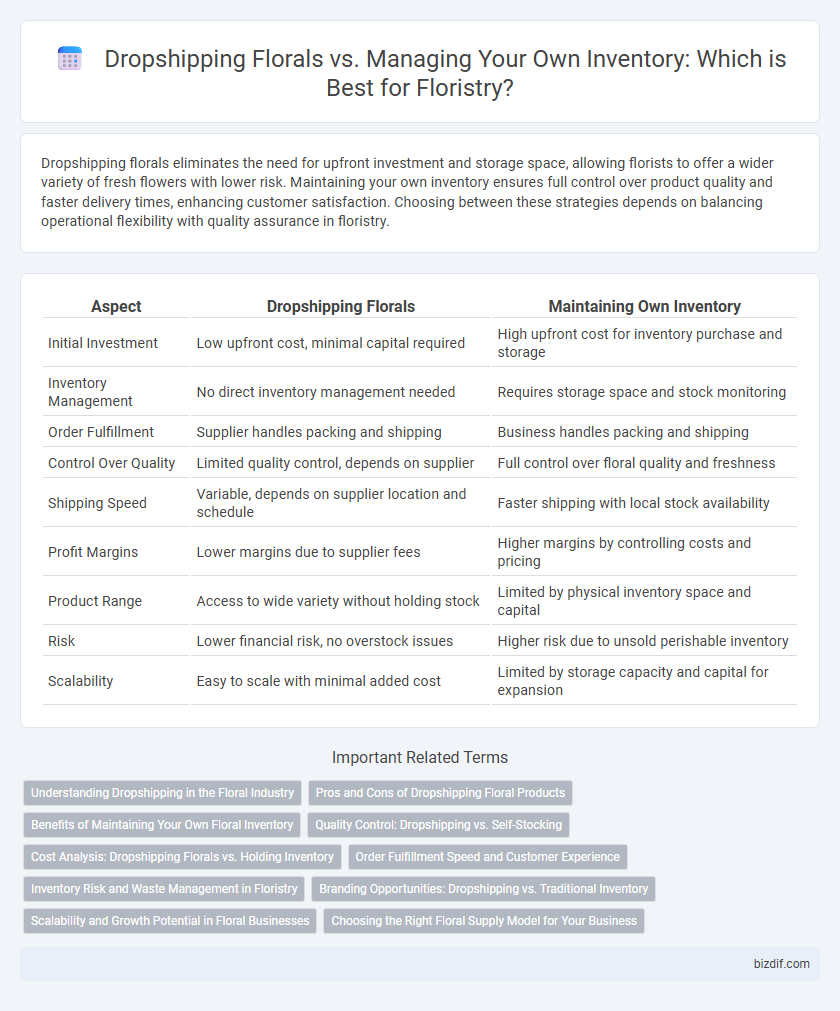Dropshipping florals eliminates the need for upfront investment and storage space, allowing florists to offer a wider variety of fresh flowers with lower risk. Maintaining your own inventory ensures full control over product quality and faster delivery times, enhancing customer satisfaction. Choosing between these strategies depends on balancing operational flexibility with quality assurance in floristry.
Table of Comparison
| Aspect | Dropshipping Florals | Maintaining Own Inventory |
|---|---|---|
| Initial Investment | Low upfront cost, minimal capital required | High upfront cost for inventory purchase and storage |
| Inventory Management | No direct inventory management needed | Requires storage space and stock monitoring |
| Order Fulfillment | Supplier handles packing and shipping | Business handles packing and shipping |
| Control Over Quality | Limited quality control, depends on supplier | Full control over floral quality and freshness |
| Shipping Speed | Variable, depends on supplier location and schedule | Faster shipping with local stock availability |
| Profit Margins | Lower margins due to supplier fees | Higher margins by controlling costs and pricing |
| Product Range | Access to wide variety without holding stock | Limited by physical inventory space and capital |
| Risk | Lower financial risk, no overstock issues | Higher risk due to unsold perishable inventory |
| Scalability | Easy to scale with minimal added cost | Limited by storage capacity and capital for expansion |
Understanding Dropshipping in the Floral Industry
Dropshipping in the floral industry allows florists to offer a wide range of flowers without the overhead of maintaining physical inventory, reducing upfront costs and minimizing waste. This model relies on third-party suppliers to fulfill orders directly to customers, enabling faster scalability and access to diverse floral varieties. However, managing product quality and delivery times can be challenging compared to traditional inventory management, where florists maintain control over fresh stock and customer experience.
Pros and Cons of Dropshipping Floral Products
Dropshipping floral products eliminates the need for maintaining costly inventory and reduces upfront investment, offering flexibility and lowered risk for florists. However, it often results in less control over product quality, limited customization options, and longer delivery times, which can impact customer satisfaction. Balancing these factors is essential for florists to decide if dropshipping aligns with their brand reliability and service standards.
Benefits of Maintaining Your Own Floral Inventory
Maintaining your own floral inventory ensures fresher, higher-quality blooms with better shelf life, directly enhancing customer satisfaction and brand reputation. It allows for greater control over product variety, enabling customization and timely restocking based on market trends and seasonal availability. This approach reduces dependency on third-party suppliers, minimizing shipping delays and potential damage, ultimately improving profit margins and operational efficiency.
Quality Control: Dropshipping vs. Self-Stocking
Maintaining your own floral inventory allows for rigorous quality control, ensuring fresh, vibrant blooms that meet your brand's standards before delivery. Dropshipping florals often results in less oversight on product quality, increasing the risk of wilted or damaged flowers arriving at customers' doorsteps. Investing in self-stocking enhances customer satisfaction by enabling precise quality checks and immediate replacement of subpar arrangements.
Cost Analysis: Dropshipping Florals vs. Holding Inventory
Dropshipping florals eliminates upfront inventory costs and reduces storage expenses, optimizing cash flow for floristry businesses. Holding own inventory incurs higher costs for bulk purchasing, refrigeration, and potential flower wastage due to perishability, increasing overall operational expenses. A detailed cost analysis reveals dropshipping offers lower financial risk and scalability, while in-house inventory allows for immediate fulfillment and customization control.
Order Fulfillment Speed and Customer Experience
Dropshipping florals enables faster order fulfillment by eliminating the need for inventory management, allowing direct shipment from suppliers to customers, which enhances delivery speed and reduces handling errors. Maintaining own inventory offers greater control over product quality and packaging, leading to a more consistent customer experience but may result in longer processing times due to stocking and fulfillment logistics. Balancing order fulfillment speed with quality control impacts customer satisfaction and repeat business in the competitive floristry market.
Inventory Risk and Waste Management in Floristry
Dropshipping florals eliminates inventory risk by allowing florists to fulfill orders directly from suppliers, reducing the need for upfront investment in stock and minimizing waste from unsold flowers. Maintaining own inventory provides greater control over quality and customization but increases exposure to perishability and potential losses due to unsold or damaged floral products. Effective waste management in owned inventory models requires precise demand forecasting and efficient supply chain coordination to balance freshness with customer satisfaction.
Branding Opportunities: Dropshipping vs. Traditional Inventory
Dropshipping florals limits branding opportunities as products typically arrive in generic packaging controlled by third-party suppliers, reducing the ability to create a unique customer experience. Maintaining your own inventory allows for customized packaging, personalized inserts, and quality control that reinforce brand identity and build customer loyalty. Investing in branded materials and exclusive floral arrangements enhances recognition and differentiates your business in the competitive floristry market.
Scalability and Growth Potential in Floral Businesses
Dropshipping florals offers scalable growth by eliminating the need for physical inventory, reducing overhead costs, and enabling rapid expansion into diverse markets. Maintaining own inventory allows for greater quality control and customization, but requires significant upfront investment and limits scalability due to storage and perishability constraints. Floral businesses leveraging dropshipping can quickly adapt to demand fluctuations and expand product offerings without the logistical challenges of inventory management.
Choosing the Right Floral Supply Model for Your Business
Choosing the right floral supply model significantly impacts profitability and customer satisfaction in floristry. Dropshipping florals minimizes inventory costs and reduces waste by sourcing flowers directly from suppliers, allowing businesses to scale quickly without storage concerns. Maintaining your own inventory provides greater control over flower quality and availability, enabling personalized arrangements and faster order fulfillment, essential for building a loyal customer base.
Dropshipping florals vs maintaining own inventory Infographic

 bizdif.com
bizdif.com